Cantilevered Piezoelectric Micro Generator Design Issues and Application to the Mining Locomotive
Abstract
1. Introduction
2. Context, Problematic, Main Contributions and Comparison with Related Work
2.1. Context of the Study
2.2. Problematic and Main Contributions
- Define the design consideration of PMG.
- Undertake an analytical study of a PMG by provides the design equations.
- Vibration levels detected in a mining locomotive.
- Design, modeling, and simulation of PMG dedicated to WSs for industrial applications.
- Estimation of the level of harvestable power in a mining locomotive.
- Performance evaluation of the WS powered by the harvested energy.
2.3. Comparison with Related Works
3. Design Consideration of a Piezoelectric Micro Generator for Wireless Sensor
3.1. Generic Model for Converting Vibrations into Electrical Energy
3.2. The Piezoelectric Transducer (PT) Design
3.2.1. PT Design Equations
Resonance Frequency of the PT
Open Circuit Voltage of a PT
Output Power of the PT
3.2.2. Electrical Model of PT
3.3. The Non-Linear Circuit Design
3.3.1. Non-Linear Circuit Principle
3.3.2. Control Circuit for the Synchronized Switch Harvesting on Inductor (SSHI) Technique
3.4. Alternating Current/Direct Current (AC/DC) Converter, DC/DC Converter and Wireless Sensor (WS) Performance
3.4.1. Standard Rectifier-Capacitor Circuit (SRCC)
3.4.2. Active Rectifier Capacitor (ARC)
3.4.3. Piezoelectric Micro Generator (PMG) with SSHI
4. Design of an Optimized PMG for Supplying IWSs: The Case of a Mining Locomotive
4.1. Test Locomotive and Measured Vibration
4.2. Modeling of the PT and Open Circuit Performance
4.3. PMG and WS Performances
- Figure 21a deals with applications for which measurements are to be taken every minute. The curve shows that it is only by considering all the proposed optimizations that it is possible to transmit data at only .
- Figure 21b represents the case where a physical quantity must be checked every two minutes. When designing the PMG with a DC/DC converter, it is possible to transmit data at . If all optimization solutions are considered, then the data can be transmitted up to 618 m. The standard circuit, as well as the only SSHI optimization, does not offer enough energy for the WS to transmit.
- Figure 21c examines the case of applications where measurements are to be made every 5 min. The performance of the standard circuit does not always allow the WS to transmit while using the SSHI technique; it is possible to communicate to around .
- Figure 21d considers the case where measurements can be taken every 7 min. Even with this low duty cycle, the WS powered by the standard circuit can only transmit at ; while considering the optimal solution, it is possible to send data to about .
5. Conclusions
Author Contributions
Funding
Conflicts of Interest
References
- Leitão, P.; Colombo, A.W.; Karnouskos, S. Industrial automation based on cyber-physical systems technologies: Prototype implementations and challenges. Comput. Ind. 2016, 81, 11–25. [Google Scholar] [CrossRef]
- Valente, G.; Muttillo, V.; Muttillo, M.; Barile, G.; Leoni, A.; Tiberti, W.; Pomante, L. SPOF—Slave Powerlink on FPGA for Smart Sensors and Actuators Interfacing for Industry 4.0 Applications. Energies 2019, 12, 1633. [Google Scholar] [CrossRef]
- Fortino, G.; Trunfio, P. Internet of Things Based on Smart Objects: Technology, Middleware and Applications; Springer: Berlin, Germany, 2014. [Google Scholar]
- Minoli, D.; Sohraby, K.; Occhiogrosso, B. IoT considerations, requirements, and architectures for smart buildings—Energy optimization and next-generation building management systems. IEEE Internet Things J. 2017, 4, 269–283. [Google Scholar] [CrossRef]
- Asada, G.; Burstein, A.; Chang, D.; Dong, M.; Fielding, M.; Kruglick, E.; Ho, J.; Lin, F.; Lin, T.; Marcy, H. Low power wireless communication and signal processing circuits for distributed microsensors. In Proceedings of the 1997 IEEE International Symposium on Circuits and Systems (ISCAS), Hong Kong, China, 12 June 1997; pp. 2817–2820. [Google Scholar]
- Zhu, Q.; Guan, M.; He, Y. Vibration energy harvesting in automobiles to power wireless sensors. In Proceedings of the 2012 IEEE International Conference on Information and Automation, Shenyang, China, 6–8 June 2012; pp. 349–354. [Google Scholar]
- Dong, M.J.; Yung, K.G.; Kaiser, W.J. Low power signal processing architectures for network microsensors. In Proceedings of the 1997 International Symposium on Low Power Electronics and Design, Monterey, CA, USA, 18–20 August 1997; pp. 173–177. [Google Scholar]
- Li, X.; Li, D.; Wan, J.; Vasilakos, A.V.; Lai, C.-F.; Wang, S. A review of industrial wireless networks in the context of industry 4.0. Wirel. Netw. 2017, 23, 23–41. [Google Scholar] [CrossRef]
- Chen, M.; Wan, J.; González-Valenzuela, S.; Liao, X.; Leung, V.C. A Survey of Recent Developments in Home M2M Networks. IEEE Commun. Surv. Tutor. 2014, 16, 98–114. [Google Scholar] [CrossRef]
- Li, Z.; Outbib, R.; Giurgea, S.; Hissel, D. Fault diagnosis for PEMFC systems in consideration of dynamic behaviors and spatial inhomogeneity. IEEE Trans. Energy Convers. 2018, 34, 3–11. [Google Scholar] [CrossRef]
- Felser, M. Real-time ethernet-industry prospective. Proc. IEEE 2005, 93, 1118–1129. [Google Scholar] [CrossRef]
- Tanneru, H.K.; Kuruvinashetti, K.; Pillay, P.; Rengaswamy, R.; Packirisamy, M. Feasibility Studies of Micro Photosynthetic Power Cells as a Competitor of Photovoltaic Cells for Low and Ultra-Low Power IoT Applications. Energies 2019, 12, 1595. [Google Scholar] [CrossRef]
- Chalasani, S.; Conrad, J.M. A survey of energy harvesting sources for embedded systems. In Proceedings of the IEEE Southeastcon 2008, Huntsville, AL, USA, 3–6 April 2008; pp. 442–447. [Google Scholar]
- Gungor, V.C.; Hancke, G.P. Industrial wireless sensor networks: Challenges, design principles, and technical approaches. IEEE Trans. Ind. Electron. 2009, 56, 4258–4265. [Google Scholar] [CrossRef]
- Mouapi, A.; Mrad, H.; Parsad, A. Implementation of a Reliability Test Protocol for a Multimeasurement Sensor dedicated to Industrial Applications of the Internet of Things. Measurement 2019, 107312. [Google Scholar] [CrossRef]
- Shrouf, F.; Ordieres, J.; Miragliotta, G. Smart Factories in Industry 4.0: A Review of the Concept and of Energy Management Approached in Production Based on the Internet of Things Paradigm. In Proceedings of the 2014 IEEE International Conference on Industrial Engineering and Engineering Management (IEEM), Bandar Sunway, Malaysia, 9–12 December 2014; pp. 697–701. [Google Scholar]
- Roundy, S. Shad Roundy—Associate Professor. Available online: https://mech.utah.edu/faculty/shad-roundy/ (accessed on 15 January 2017).
- Roundy, S.; Steingart, D.; Frechette, L.; Wright, P.; Rabaey, J. Power Sources for Wireless Sensor Networks. In Proceedings of the European Workshop on Wireless Sensor Networks, Berlin, Germany, 19–21 January 2004; pp. 1–17. [Google Scholar]
- Roundy, S.; Wright, P.K. A piezoelectric vibration based generator for wireless electronics. Smart Mater. Struct. 2004, 13, 1131. [Google Scholar] [CrossRef]
- Roundy, S.; Wright, P.K.; Rabaey, J. A study of low level vibrations as a power source for wireless sensor nodes. Comput. Commun. 2003, 26, 1131–1144. [Google Scholar] [CrossRef]
- Yeo, H.G.; Xue, T.; Roundy, S.; Ma, X.; Rahn, C.; Trolier-McKinstry, S. Piezoelectric MEMS Energy Harvesters for Powering Sensor Systems. Multidiscip. Digit. Publ. Inst. Proc. 2018, 2, 1103. [Google Scholar] [CrossRef]
- Guyomar, D.; Badel, A.; Lefeuvre, E.; Richard, C. Toward energy harvesting using active materials and conversion improvement by nonlinear processing. IEEE Trans. Ultrason. Ferroelectr. Freq. Control 2005, 52, 584–595. [Google Scholar] [CrossRef]
- Lefeuvre, E.; Badel, A.; Petit, L.; Richard, C.; Guyomar, D. Semi-passive piezoelectric structural damping by synchronized switching on voltage sources. J. Intell. Mater. Syst. Struct. 2006, 17, 653–660. [Google Scholar] [CrossRef]
- Guyomar, D.; Lallart, M. Recent progress in piezoelectric conversion and energy harvesting using nonlinear electronic interfaces and issues in small scale implementation. Micromachines 2011, 2, 274–294. [Google Scholar] [CrossRef]
- Guyomar, D.; Badel, A. Nonlinear semi-passive multimodal vibration damping: An efficient probabilistic approach. J. Sound Vib. 2006, 294, 249–268. [Google Scholar] [CrossRef]
- Soeleman, H.; Roy, K.; Paul, B. Robust Ultra-Low Power Sub-Threshold DTMOS Logic. In Proceedings of the 2000 International Symposium on Low Power Electronics and Design, Rapallo, Italy, 25–27 July 2000; pp. 25–30. [Google Scholar]
- Kim, J.-J.; Roy, K. Double gate-MOSFET subthreshold circuit for ultralow power applications. IEEE Trans. Electron Devices 2004, 51, 1468–1474. [Google Scholar] [CrossRef]
- Yamane, T.; Hamamura, S.; Zaitsu, T.; Minomiya, T.; Shoyama, M.; Fuda, Y. Efficiency Improvement of Piezoelectric-Transformer DC-DC Converter. In Proceedings of the PESC 98 Record. 29th Annual IEEE Power Electronics Specialists Conference, Fukuoka, Japan, 22 May 1998; pp. 1255–1261. [Google Scholar]
- Ottman, G.K.; Hofmann, H.F.; Lesieutre, G.A. Optimized piezoelectric energy harvesting circuit using step-down converter in discontinuous conduction mode. IEEE Trans. Power Electron. 2003, 18, 696–703. [Google Scholar] [CrossRef]
- Lefeuvre, E.; Audigier, D.; Richard, C.; Guyomar, D. Buck-boost converter for sensorless power optimization of piezoelectric energy harvester. IEEE Trans. Power Electron. 2007, 22, 2018–2025. [Google Scholar] [CrossRef]
- Ottman, G.K.; Hofmann, H.F.; Bhatt, A.C.; Lesieutre, G.A. Adaptive piezoelectric energy harvesting circuit for wireless remote power supply. IEEE Trans. Power Electron. 2002, 17, 669–676. [Google Scholar] [CrossRef]
- Kong, N.; Ha, D.S. Low-power design of a self-powered piezoelectric energy harvesting system with maximum power point tracking. IEEE Trans. Power Electron. 2012, 27, 2298–2308. [Google Scholar] [CrossRef]
- Halgamuge, M.N.; Zukerman, M.; Ramamohanarao, K.; Vu, H.L. An estimation of sensor energy consumption. Prog. Electromagn. Res. 2009, 12, 259–295. [Google Scholar] [CrossRef]
- Mouapi, A.; Hakem, N. A New Approach to Design Autonomous Wireless Sensor Node Based on RF Energy Harvesting System. Sensors 2018, 18, 133. [Google Scholar] [CrossRef]
- Duarte-Melo, E.J.; Liu, M. Analysis of Energy Consumption and Lifetime of Heterogeneous Wireless Sensor Networks. In Proceedings of the IEEE Global Telecommunications Conference, GLOBECOM’02, Taipei, Taiwan, 17–21 November 2002; pp. 21–25. [Google Scholar]
- Chang, J.-H.; Tassiulas, L. Maximum lifetime routing in wireless sensor networks. IEEE/ACM Trans. Netw. 2004, 12, 609–619. [Google Scholar] [CrossRef]
- Heinzelman, W.R.; Chandrakasan, A.; Balakrishnan, H. Energy-Efficient Communication protocol for Wireless Microsensor Networks. In Proceedings of the 33rd Annual Hawaii International Conference on System Sciences, Maui, HI, USA, 7 January 2000; Volume 12, p. 10. [Google Scholar]
- Marcelloni, F.; Vecchio, M. A simple algorithm for data compression in wireless sensor networks. IEEE Commun. Lett. 2008, 12, 411–413. [Google Scholar] [CrossRef]
- Schurgers, C.; Srivastava, M.B. Energy Efficient Routing in Wireless Sensor Networks. In Proceedings of the 2001, MILCOM Proceedings for Network-Centric Operations: Creating the Information Force, McLean, VA, USA, 28–31 October 2001; pp. 357–361. [Google Scholar]
- Toprak, A.; Tigli, O. Piezoelectric energy harvesting: State-of-the-art and challenges. Appl. Phys. Rev. 2014, 1, 031104. [Google Scholar] [CrossRef]
- Khaligh, A.; Zeng, P.; Zheng, C. Kinetic energy harvesting using piezoelectric and electromagnetic technologies—state of the art. IEEE Trans. Ind. Electron. 2010, 57, 850–860. [Google Scholar] [CrossRef]
- Niezrecki, C.; Brei, D.; Balakrishnan, S.; Moskalik, A. Piezoelectric actuation: State of the art. Shock Vib. Digest 2001, 33, 269–280. [Google Scholar] [CrossRef]
- Renaud, M.; Karakaya, K.; Sterken, T.; Fiorini, P.; Van Hoof, C.; Puers, R. Fabrication, modelling and characterization of MEMS piezoelectric vibration harvesters. Sens. Actuators A Phys. 2008, 145, 380–386. [Google Scholar] [CrossRef]
- Lu, F.; Lee, H.; Lim, S. Modeling and analysis of micro piezoelectric power generators for micro-electromechanical-systems applications. Smart Mater. Struct. 2003, 13, 57. [Google Scholar] [CrossRef]
- Harb, A. Energy harvesting: State-of-the-art. Renew. Energy 2011, 36, 2641–2654. [Google Scholar] [CrossRef]
- Caliò, R.; Rongala, U.B.; Camboni, D.; Milazzo, M.; Stefanini, C.; De Petris, G.; Oddo, C.M. Piezoelectric energy harvesting solutions. Sensors 2014, 14, 4755–4790. [Google Scholar] [CrossRef] [PubMed]
- Beeby, S.P.; Tudor, M.J.; White, N. Energy harvesting vibration sources for microsystems applications. Meas. Sci. Technol. 2006, 17, R175. [Google Scholar] [CrossRef]
- Gafforelli, G.; Ardito, R.; Corigliano, A. Improved one-dimensional model of piezoelectric laminates for energy harvesters including three dimensional effects. Compos. Struct. 2015, 127, 369–381. [Google Scholar] [CrossRef]
- Gafforelli, G.; Corigliano, A.; Xu, R.; Kim, S.-G. Experimental verification of a bridge-shaped, nonlinear vibration energy harvester. Appl. Phys. Lett. 2014, 105, 203901. [Google Scholar] [CrossRef]
- Williams, C.; Yates, R.B. Analysis of a micro-electric generator for microsystems. Sens. Actuators A Phys. 1996, 52, 8–11. [Google Scholar] [CrossRef]
- Priya, S.; Inman, D.J. Energy Harvesting Technologies; Springer: New York, NY, USA, 2009; Volume 21. [Google Scholar]
- Mouapi, A.; Hakem, N.; Kandil, N.; Kamani, G.V. Energy Harvesting Design for Autonomous Wireless Sensors Network Applied to Trains. In Proceedings of the 2016 IEEE International Ultrasonics Symposium (IUS), Tours, France, 18–21 September 2016; pp. 1–4. [Google Scholar]
- Mason, W.P. Piezoelectricity, its history and applications. J. Acoust. Soc. Am. 1981, 70, 1561–1566. [Google Scholar] [CrossRef]
- Saadon, S.; Sidek, O. A review of vibration-based MEMS piezoelectric energy harvesters. Energy Convers. Manag. 2011, 52, 500–504. [Google Scholar] [CrossRef]
- Renaud, M.; Sterken, T.; Fiorini, P.; Puers, R.; Baert, K.; Van Hoof, C. Scavenging Energy from Human Body: Design of a Piezoelectric Transducer. In Proceedings of the 13th International Conference on Solid-State Sensors, Actuators and Microsystems, 2005, Digest of Technical Papers, TRANSDUCERS’05, Seoul, Korea, 5–9 June; 2005; pp. 784–787. [Google Scholar]
- Smits, J.G.; Ballato, A. Dynamic Behavior of Piezoelectric Bimorphs. In Proceedings of the Ultrasonics Symposium, Baltimore, MD, USA, 31 October–3 November 1993; p. 463. [Google Scholar]
- Smits, J.G.; Choi, W.-S. The constituent equations of piezoelectric heterogeneous bimorphs. IEEE Trans. Ultrason. Ferroelectr. Freq. Control 1991, 38, 256–270. [Google Scholar] [CrossRef]
- Lee, H.J.; Sherrit, S.; Tosi, L.P.; Walkemeyer, P.; Colonius, T. Piezoelectric energy harvesting in internal fluid flow. Sensors 2015, 15, 26039–26062. [Google Scholar] [CrossRef] [PubMed]
- Khanna, R.; Pisharody, G.; Carlson, C.R. Coordinator for Low Power Sensor nEtwork with Tree or Star Topology. Google Patents 10,462,224, 3 January 2019. [Google Scholar]
- Chakraborty, I.; Chakraborty, A.; Das, P. Sensor Selection and Data Fusion Approach for IoT Applications. In Recent Developments in Machine Learning and Data Analytics; Springer: New York, NY, USA, 2019; pp. 17–33. [Google Scholar]
- Akyildiz, I.F.; Wang, X.; Wang, W. Wireless mesh networks: A survey. Comput. Netw. 2005, 47, 445–487. [Google Scholar] [CrossRef]
- Abbasi, A.A.; Younis, M. A survey on clustering algorithms for wireless sensor networks. Comput. Commun. 2007, 30, 2826–2841. [Google Scholar] [CrossRef]
- Shrestha, A.; Xing, L. A Performance Comparison of Different Topologies for Wireless Sensor Networks. In Proceedings of the 2007 IEEE Conference on Technologies for Homeland Security, Woburn, MA, USA, 16–17 May 2007; pp. 280–285. [Google Scholar]
- Mouapi, A.; Hakem, N. Performance Evaluation of Wireless Sensor Node Powered by RF Energy Harvesting. In Proceedings of the 2016 16th Mediterranean Microwave Symposium (MMS), Abu Dhabi, UAE, 14–16 November 2016; pp. 1–4. [Google Scholar]
- Wang, A.; Chandrakasan, A. Energy-efficient DSPs for wireless sensor networks. IEEE Signal Process. Mag. 2002, 19, 68–78. [Google Scholar] [CrossRef]
- Rappaport, T.S. Wireless Communications: Principles and Practice; Prentice Hall PTR: Upper Saddle River, NJ, USA, 1996; Volume 2. [Google Scholar]
- Johnson, M.; Healy, M.; van de Ven, P.; Hayes, M.J.; Nelson, J.; Newe, T.; Lewis, E. A comparative review of wireless sensor network mote technologies. In Proceedings of the 2009 IEEE SENSORS, Christchurch, New Zealand, 25–28 October 2009; pp. 1439–1442. [Google Scholar]
- Miller, M.J.; Vaidya, N.H. A MAC protocol to reduce sensor network energy consumption using a wakeup radio. IEEE Trans. Mob. Comput. 2005, 4, 228–242. [Google Scholar] [CrossRef]
- Mouapi, A.; Hakem, N.; Delisle, G.Y. Autonomous Wireless Sensors Network Based on Piezoelectric Energy Harvesting. Open J. Antennas Propag. 2016, 4, 138. [Google Scholar] [CrossRef]
- Instruments Texas. CC2520 Datasheet: 2.4 GHz IEEE 802.15. 4/Zigbee RF Transceiver. SWRS068; Instruments Texas: Dallas, TX, USA, 2007. [Google Scholar]
- Shnayder, V.; Hempstead, M.; Chen, B.-R.; Allen, G.W.; Welsh, M. Simulating the Power Consumption of Large-Scale Sensor Network Applications. In Proceedings of the 2nd International Conference on Embedded Networked Sensor Systems, Baltimore, MD, USA, 3–5 November 2004; pp. 188–200. [Google Scholar]
- Heinzelman, W.R.; Sinha, A.; Wang, A.; Chandrakasan, A.P. Energy-Scalable Algorithms and Protocols for Wireless Microsensor Networks. In Proceedings of the 2000 IEEE International Conference on Acoustics, Speech, and Signal Processing, ICASSP’00, Istanbul, Turkey, 5–9 June 2000; pp. 3722–3725. [Google Scholar]
- Mouapi, A. Design, Modeling and Simulation of Piezoelectric Microgenerator for application in Underground Vehicles. In Proceedings of the 2019 IEEE International Conference on Environment and Electrical Engineering and 2019 IEEE Industrial and Commercial Power Systems Europe (EEEIC/I&CPS Europe), Genova, Italy, 11–14 June 2019; pp. 1–5. [Google Scholar]
- Yu, H.; Zhou, J.; Deng, L.; Wen, Z. A vibration-based MEMS piezoelectric energy harvester and power conditioning circuit. Sensors 2014, 14, 3323–3341. [Google Scholar] [CrossRef]
- Badel, A.; Guyomar, D.; Lefeuvre, E.; Richard, C. Piezoelectric energy harvesting using a synchronized switch technique. J. Intell. Mater. Syst. Struct. 2006, 17, 831–839. [Google Scholar] [CrossRef]
- Do, X.-D.; Ko, Y.-H.; Nguyen, H.-H.; Le, H.-B.; Lee, S.-G. An Efficient Parallel SSHI Rectifier for Piezoelectric Energy Scavenging Systems. In Proceedings of the 13th International Conference on Advanced Communication Technology (ICACT), Seoul, Korea, 13–16 February 2011; pp. 1394–1397. [Google Scholar]
- Mateu, L.; Lühmann, L.; Zessin, H.; Spies, P. Modified parallel SSHI AC-DC Converter for Piezoelectric Energy Harvesting Power Supplies. In Proceedings of the 2011 IEEE 33rd International Telecommunications Energy Conference (INTELEC), Amsterdam, The Netherlands, 9–13 October 2011; pp. 1–7. [Google Scholar]
- Liang, J.; Liao, W.-H. Improved design and analysis of self-powered synchronized switch interface circuit for piezoelectric energy harvesting systems. IEEE Trans. Ind. Electron. 2012, 59, 1950–1960. [Google Scholar] [CrossRef]
- Shu, Y.; Lien, I.; Wu, W. An improved analysis of the SSHI interface in piezoelectric energy harvesting. Smart Mater. Struct. 2007, 16, 2253. [Google Scholar] [CrossRef]
- Lefeuvre, E.; Badel, A.; Benayad, A.; Lebrun, L.; Richard, C.; Guyomar, D. A comparison between several approaches of piezoelectric energy harvesting. J. Phys. IV 2005, 128, 177–186. [Google Scholar] [CrossRef]
- Ammar, Y.; Basrour, S. Non Linear Techniques for Increasing Harvesting Energy from Piezoelectric and Electromagnetic Micro-Power-Generators. In Proceedings of the Technology & Engineering Symposium on Design, Test, Integration and Packaging of MEMS/MOEMS, DTIP, Stresa, Italy, 26–28 April 2006; p. 5. [Google Scholar]
- Badel, A.; Guyomar, D.; Lefeuvre, E.; Richard, C. Efficiency enhancement of a piezoelectric energy harvesting device in pulsed operation by synchronous charge inversion. J. Intell. Mater. Syst. Struct. 2005, 16, 889–901. [Google Scholar] [CrossRef]
- Qiu, J.; Jiang, H.; Ji, H.; Zhu, K. Comparison between four piezoelectric energy harvesting circuits. Front. Mech. Eng. China 2009, 4, 153–159. [Google Scholar] [CrossRef]
- Richard, C.; Guyomar, D.; Lefeuvre, E. Self-Powered Electronic Breaker with Automatic Switching by Detecting Maxima or Minima of Potential Difference between its Power Electrodes. FR2005/0030000. Publication Number: WO/2007/063194. 2007. [Google Scholar]
- Badel, A. Récupération D’énergie et Contrôle Vibratoire par Éléments Piézoélectriques Suivant une Approche non Linéaire. Ph.D. Thesis, University of Savoie, Chambéry, France, 2005. [Google Scholar]
- Lu, S.; Boussaid, F. A highly efficient P-SSHI rectifier for piezoelectric energy harvesting. IEEE Trans. Power Electron. 2015, 30, 5364–5369. [Google Scholar] [CrossRef]
- Wu, Y.; Badel, A.; Formosa, F.; Liu, W.; Agbossou, A. Self-powered optimized synchronous electric charge extraction circuit for piezoelectric energy harvesting. J. Intell. Mater. Syst. Struct. 2014, 25, 2165–2176. [Google Scholar] [CrossRef]
- Cheng, L.-C.; Kang, Y.-C.; Chen, C.-L. A Resonance-Frequency-Tracing Method for a Current-Fed Piezoelectric Transducer. IEEE Trans. Ind. Electron. 2014, 61, 6031–6040. [Google Scholar] [CrossRef]
- Priya, S.; Chen, C.-T.; Fye, D.; Zahnd, J. Piezoelectric windmill: A novel solution to remote sensing. Jpn. J. Appl. Phys. 2004, 44, L104. [Google Scholar] [CrossRef]
- Mouapi, A.; Hakem, N.; Delisle, G.Y.; Kandil, N. A Novel Piezoelectric Micro-Generator to Power Wireless Sensors Networks in Vehicles. In Proceedings of the 2015 IEEE 15th International Conference on Environment and Electrical Engineering (EEEIC), Rome, Italy, 10–13 June 2015; pp. 1089–1092. [Google Scholar]
- Ferrari, M.; Ferrari, V.; Marioli, D.; Taroni, A. Modeling, fabrication and performance measurements of a piezoelectric energy converter for power harvesting in autonomous microsystems. IEEE Trans. Instrum. Meas. 2006, 55, 2096–2101. [Google Scholar] [CrossRef]
- Hamilton, M.C. Recent advances in energy harvesting technology and techniques. In Proceedings of the IECON 2012-38th Annual Conference on IEEE Industrial Electronics Society, Montreal, QC, Canada, 25–28 October 2012; pp. 6297–6304. [Google Scholar]
- Badel, A.; Benayad, A.; Lefeuvre, E.; Lebrun, L.; Richard, C.; Guyomar, D. Single crystals and nonlinear process for outstanding vibration-powered electrical generators. IEEE Trans. Ultrason. Ferroelectr. Freq. Control 2006, 53, 673–684. [Google Scholar] [CrossRef]
- Sodano, H.A.; Inman, D.J.; Park, G. Comparison of piezoelectric energy harvesting devices for recharging batteries. J. Intell. Mater. Syst. Struct. 2005, 16, 799–807. [Google Scholar] [CrossRef]
- Phipps, A.G. Modeling and Characterization of Piezoelectric Energy Harvesting Systems with the Pulsed Resonant Converter; University of Florida: Gainesville, FL, USA, 2010. [Google Scholar]
- Marzencki, M.; Ammar, Y.; Basrour, S. Integrated power harvesting system including a MEMS generator and a power management circuit. Sens. Actuators A Phys. 2008, 145, 363–370. [Google Scholar] [CrossRef]
- Le, T.T.; Han, J.; von Jouanne, A.; Mayaram, K.; Fiez, T.S. Piezoelectric micro-power generation interface circuits. IEEE J. Solid State Circuits 2006, 41, 1411–1420. [Google Scholar] [CrossRef]
- Yang, Y.; Qi, J.; Liao, Q.; Li, H.; Wang, Y.; Tang, L.; Zhang, Y. High-performance piezoelectric gate diode of a single polar-surface dominated ZnO nanobelt. Nanotechnology 2009, 20, 125201. [Google Scholar] [CrossRef] [PubMed]
- Ngo, K.D.; Phipps, A.; Nishida, T.; Lin, J.; Xu, S. Power Converters for Piezoelectric Energy Extraction. In Proceedings of the ASME 2006 International Mechanical Engineering Congress and Exposition, Chicago, IL, USA, 5–10 November 2006; pp. 597–602. [Google Scholar]
- Kim, J.; Kim, C. A DC-DC boost converter with variation-tolerant MPPT technique and efficient ZCS circuit for thermoelectric energy harvesting applications. IEEE Trans. Power Electron. 2013, 28, 3827–3833. [Google Scholar] [CrossRef]
- Gasnier, P.; Willemin, J.; Boisseau, S.; Despesse, G.; Condemine, C.; Gouvernet, G.; Chaillout, J.-J. An autonomous piezoelectric energy harvesting IC based on a synchronous multi-shot technique. IEEE J. Solid State Circuits 2014, 49, 1561–1570. [Google Scholar] [CrossRef]
- Batarseh, I. Power Electronic Circuits; John Wiley: Hoboken, NJ, USA, 2004; Volume 426. [Google Scholar]
- Ramadass, Y.K.; Chandrakasan, A.P. An efficient piezoelectric energy harvesting interface circuit using a bias-flip rectifier and shared inductor. IEEE J. Solid State Circuits 2010, 45, 189–204. [Google Scholar] [CrossRef]
- Vernier. Accelerometers. Available online: https://www.vernier.com/products/sensors/accelerometers/ (accessed on 8 September 2018).
- Vernier. Graphical Analysis. Available online: https://www.vernier.com/products/software/graphical-analysis/ (accessed on 10 January 2017).
- MIDÉ. Packaged Piezoelectric Actuators and Sensors. Available online: https://www.mide.com/collections/vibration-energy-harvesting-with-protected-piezos (accessed on 23 December 2018).
- Seah, W.K.; Eu, Z.A.; Tan, H.-P. Wireless Sensor Networks Powered by Ambient Energy Harvesting (WSN-HEAP)-Survey and Challenges. In Proceedings of the 2009 1st International Conference on Wireless Communication, Vehicular Technology, Information Theory and Aerospace & Electronic Systems Technology, Aalborg, Denmark, 17–20 May 2009; pp. 1–5. [Google Scholar]
- Rout, R.R.; Ghosh, S.K. Enhancement of lifetime using duty cycle and network coding in wireless sensor networks. IEEE Trans. Wirel. Commun. 2013, 12, 656–667. [Google Scholar] [CrossRef]
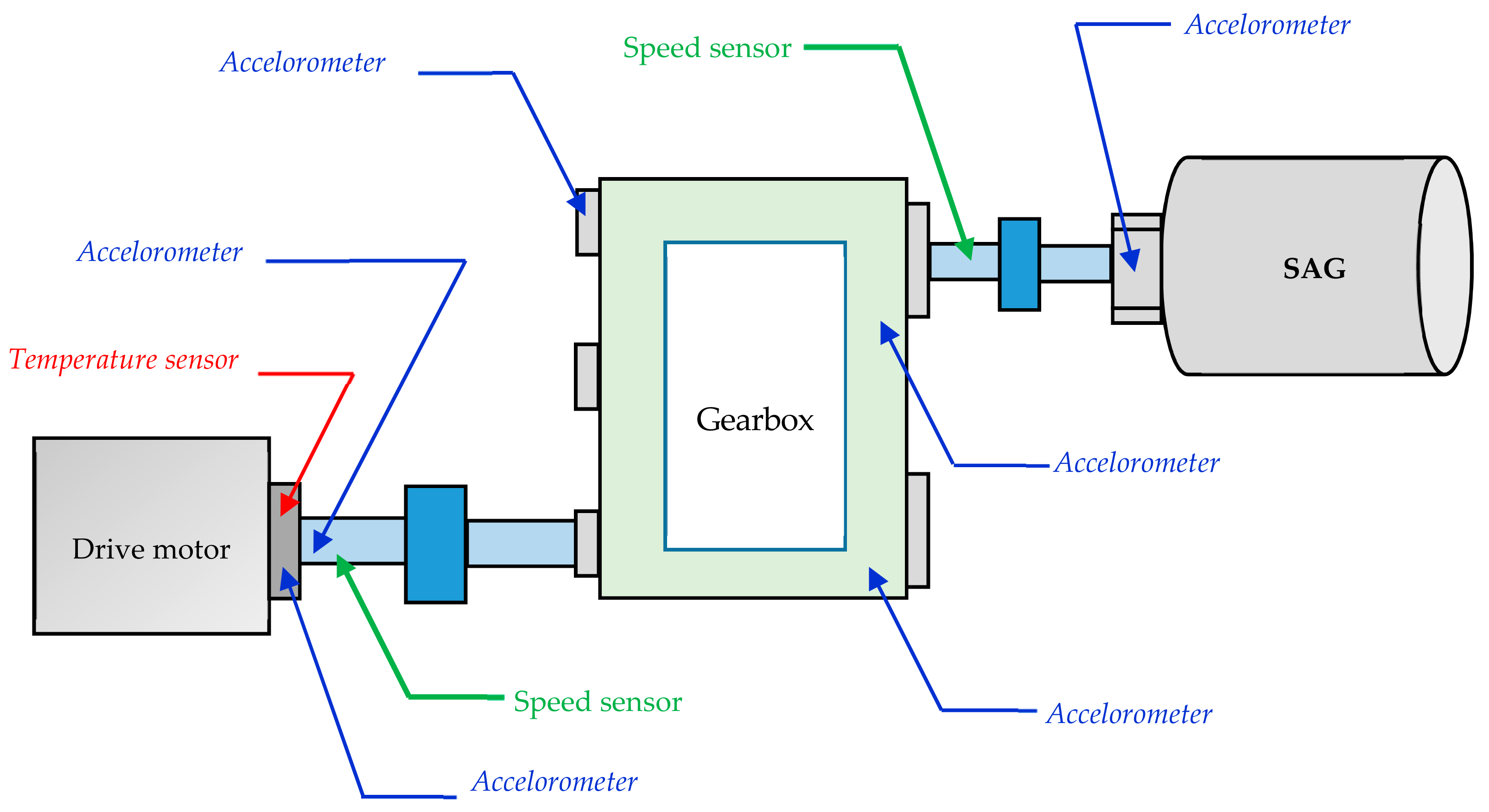
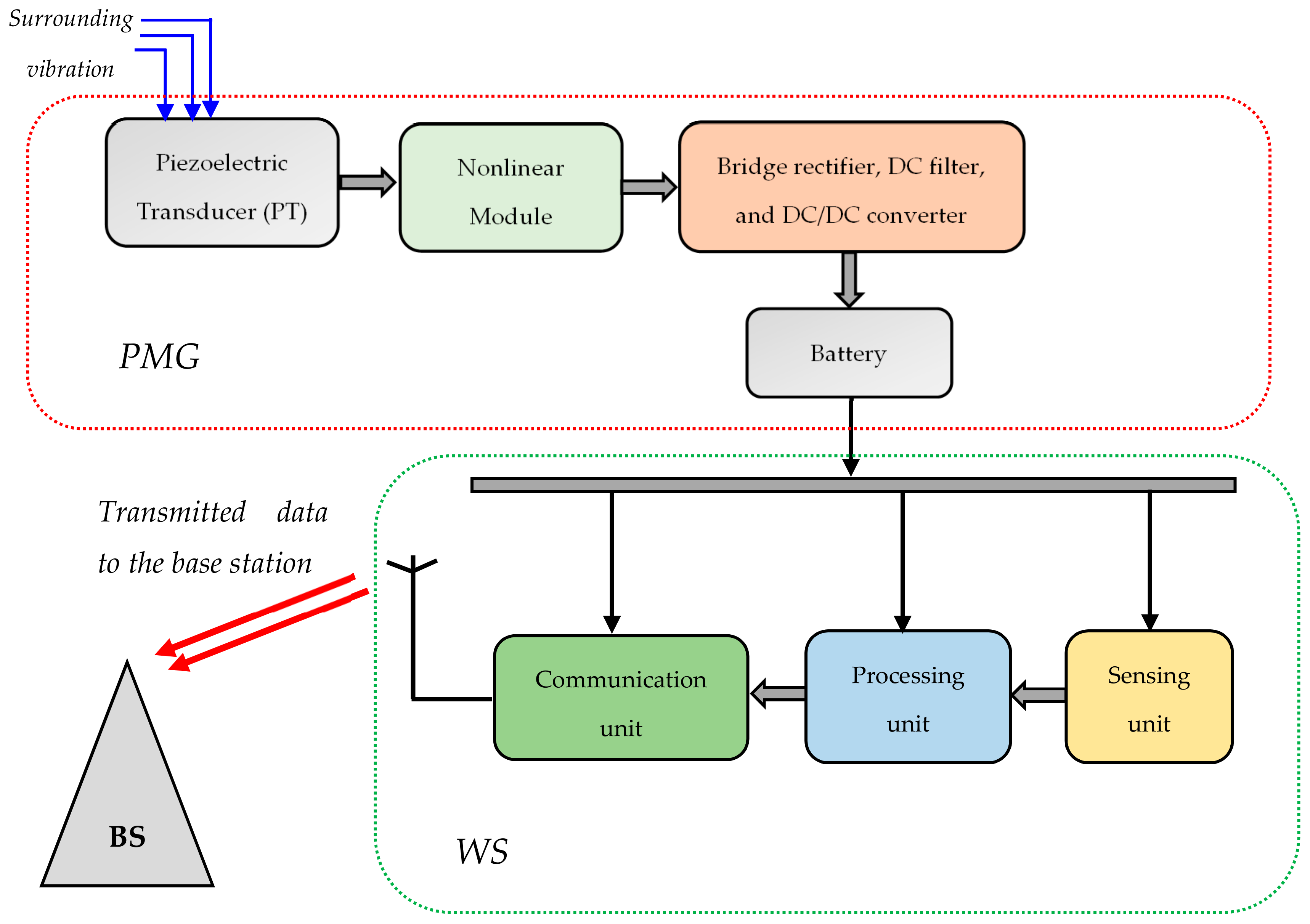
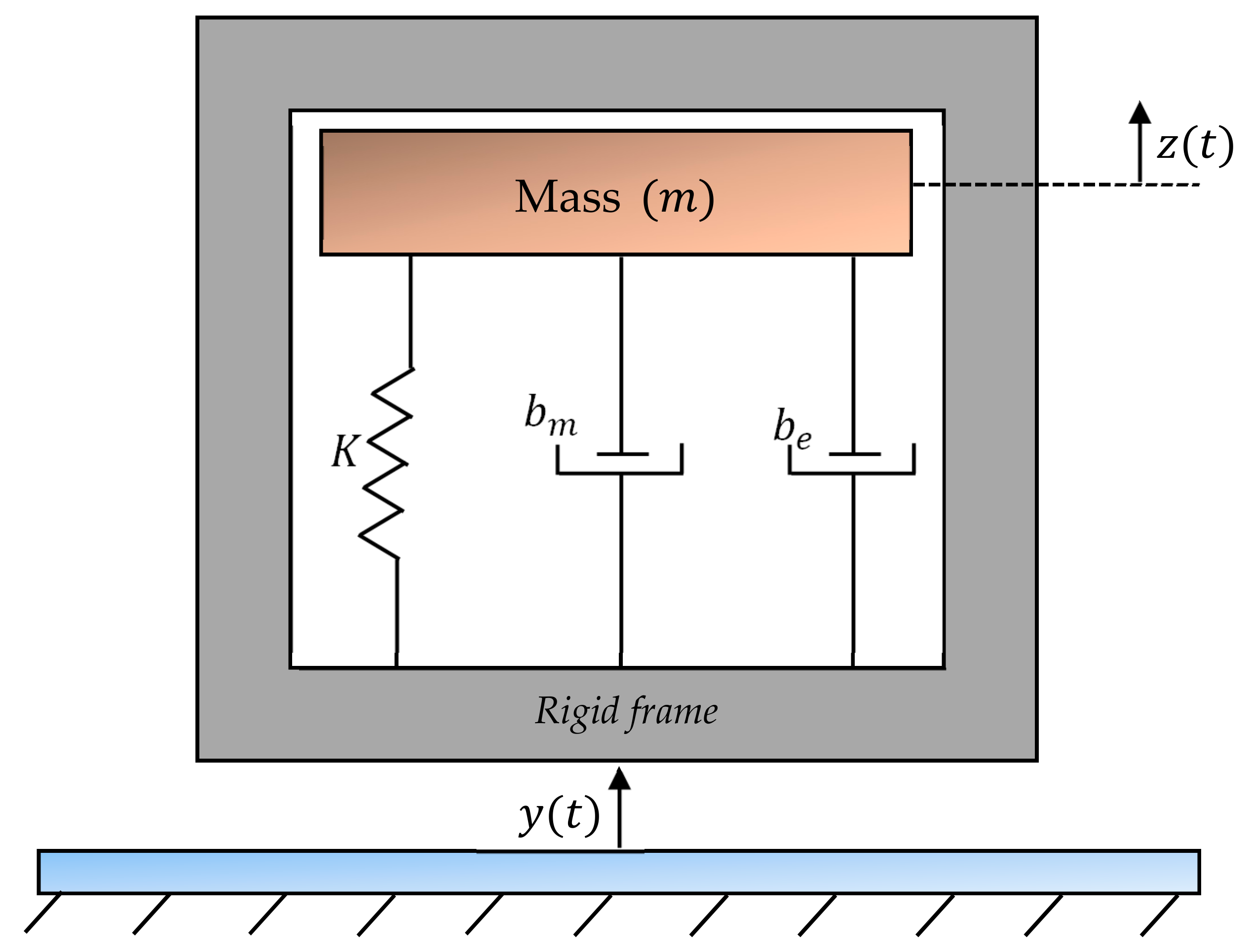
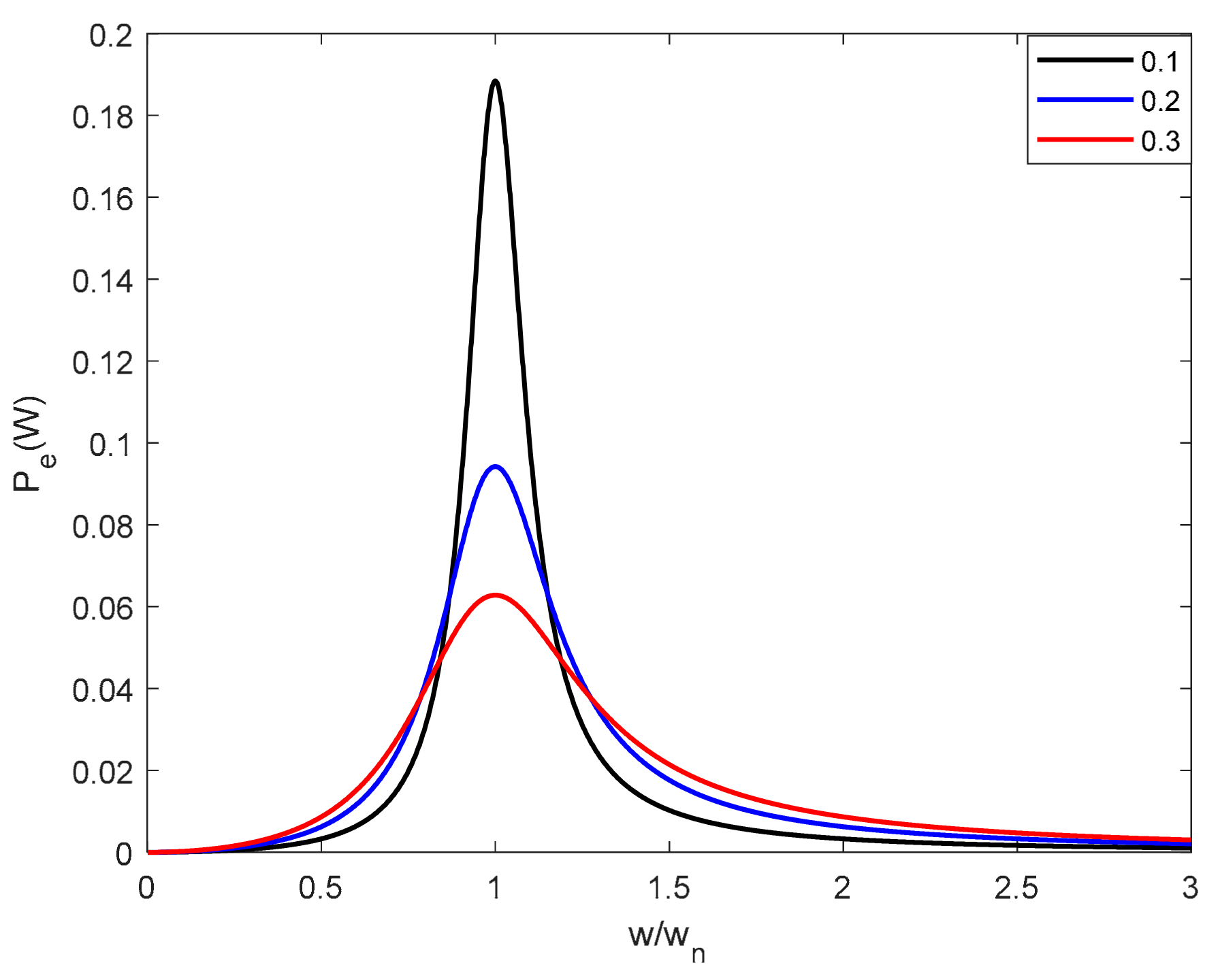
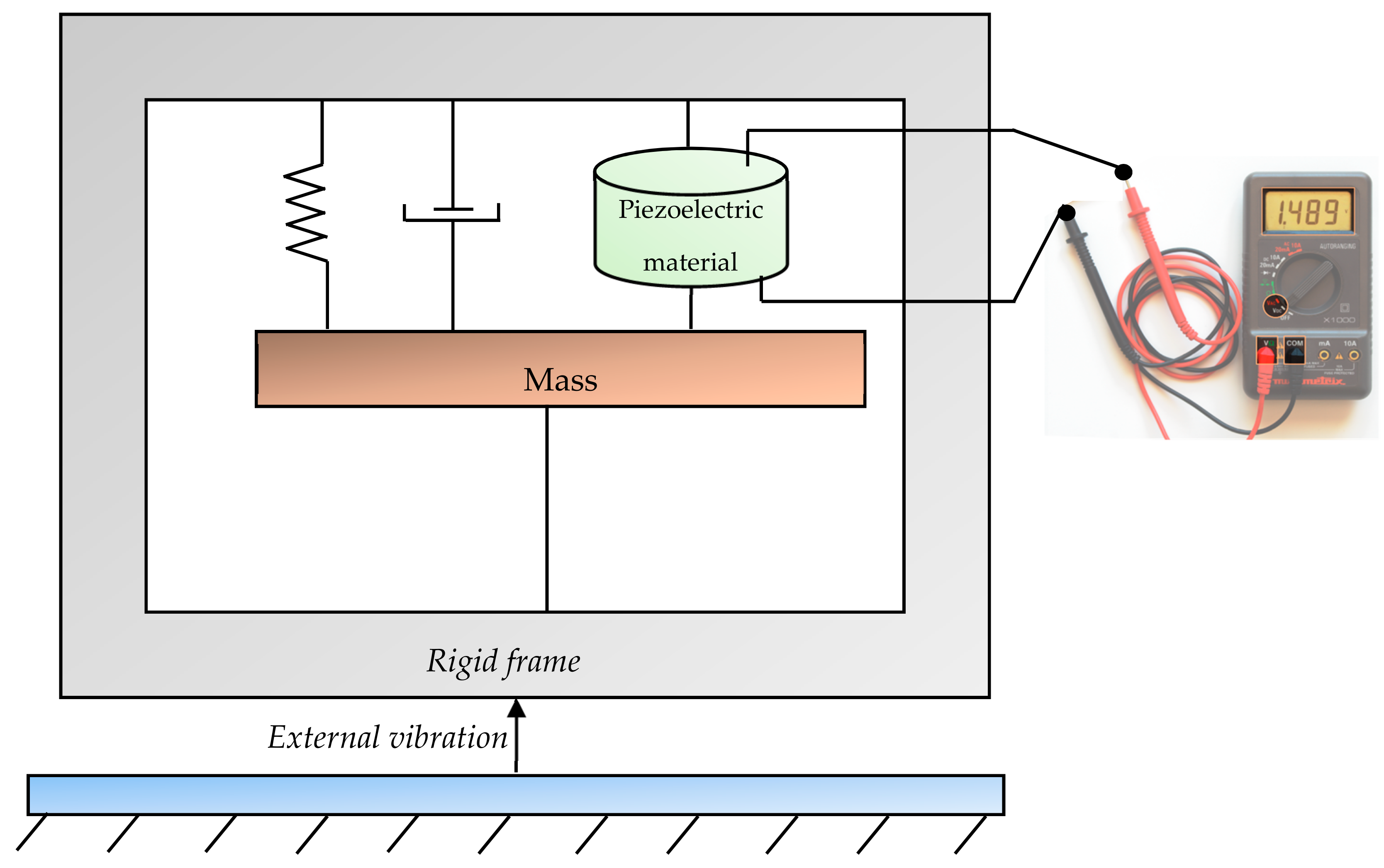
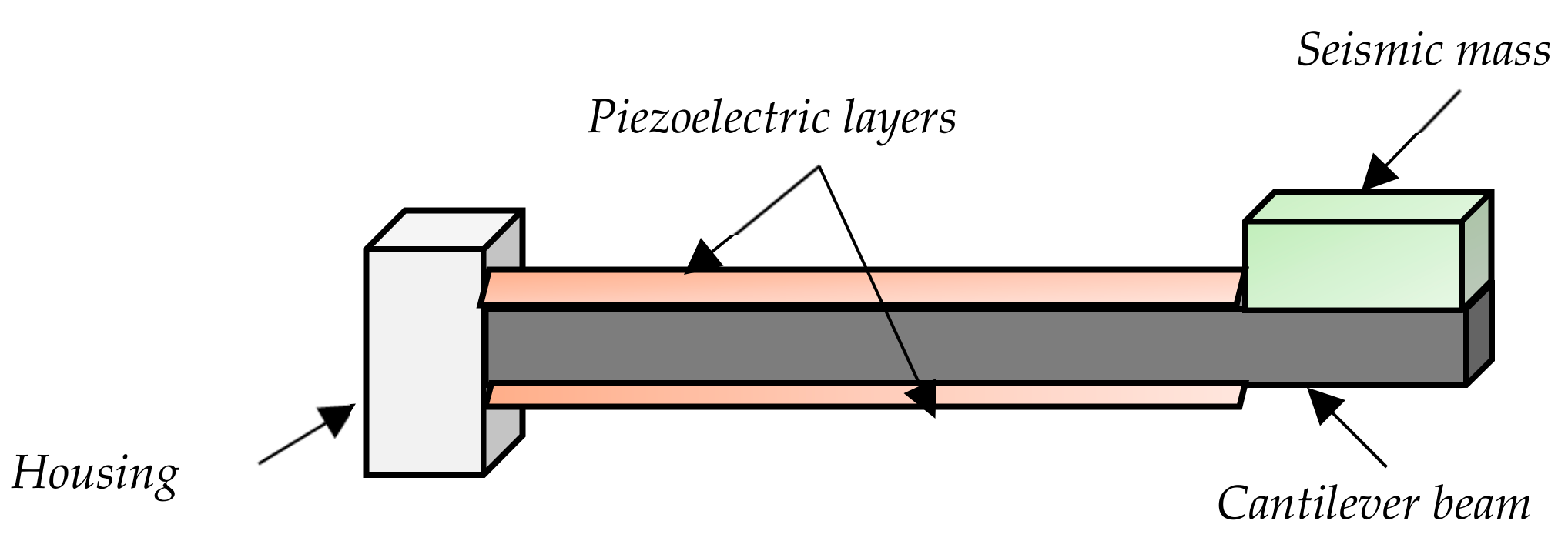
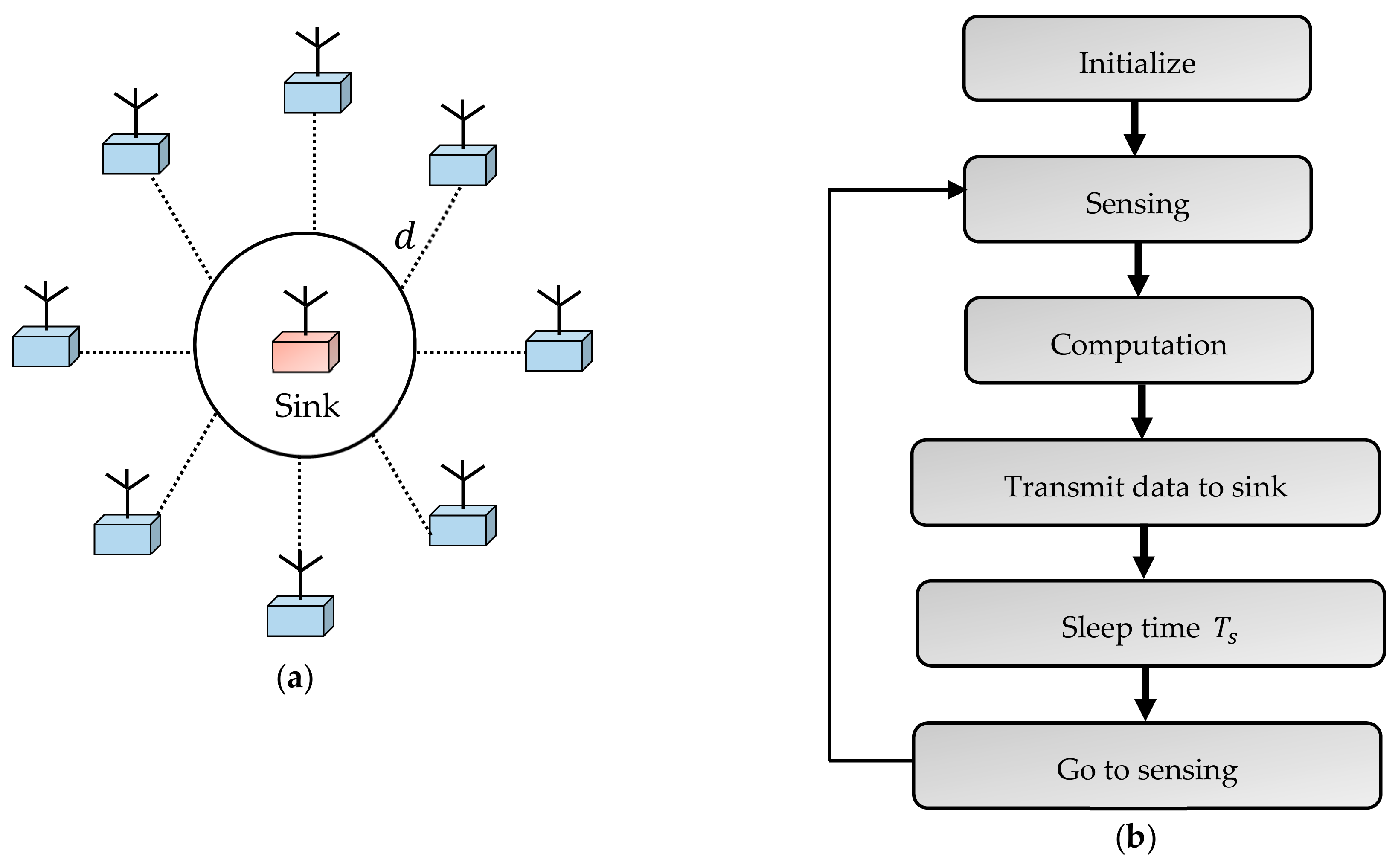
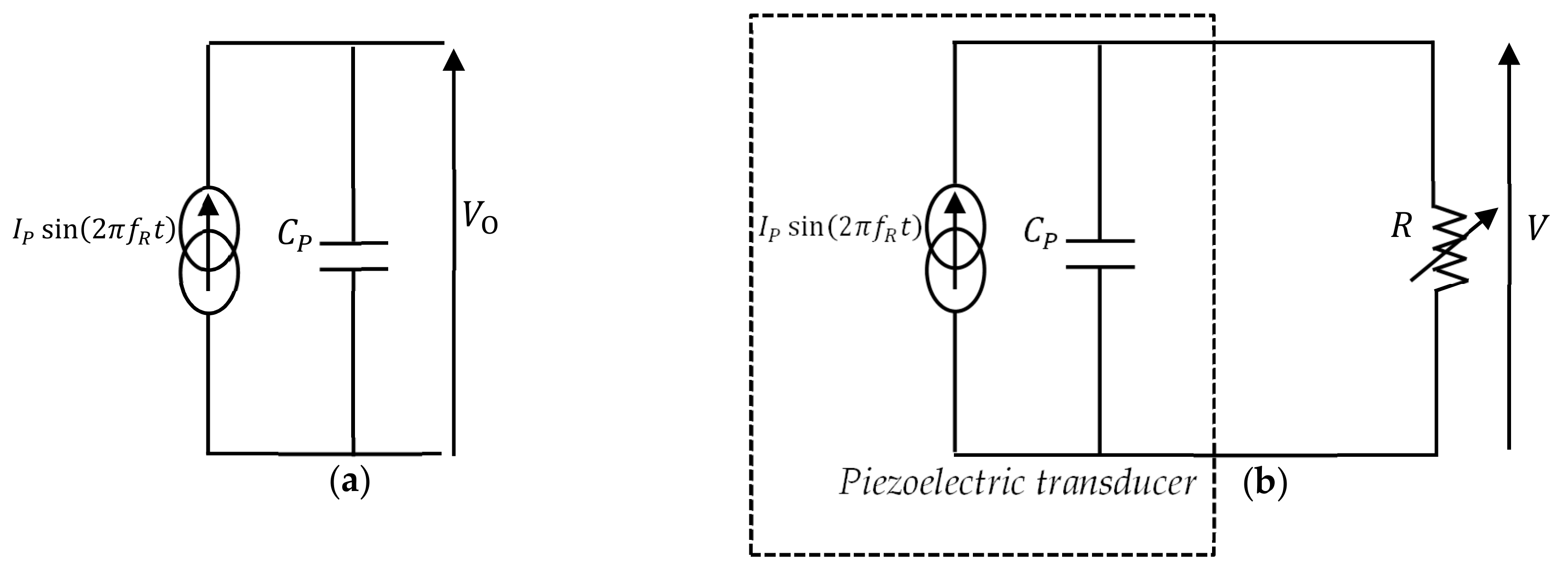

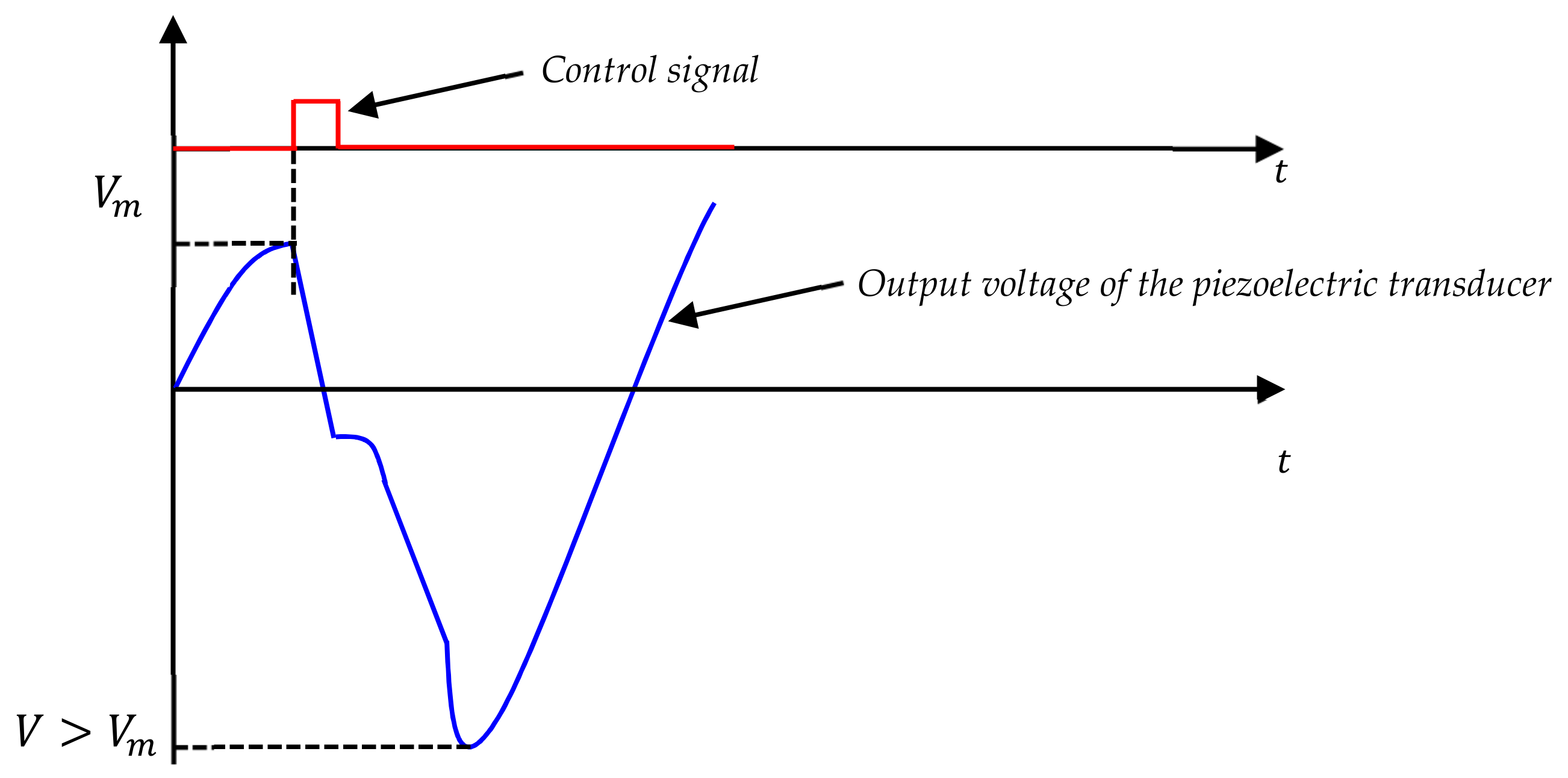



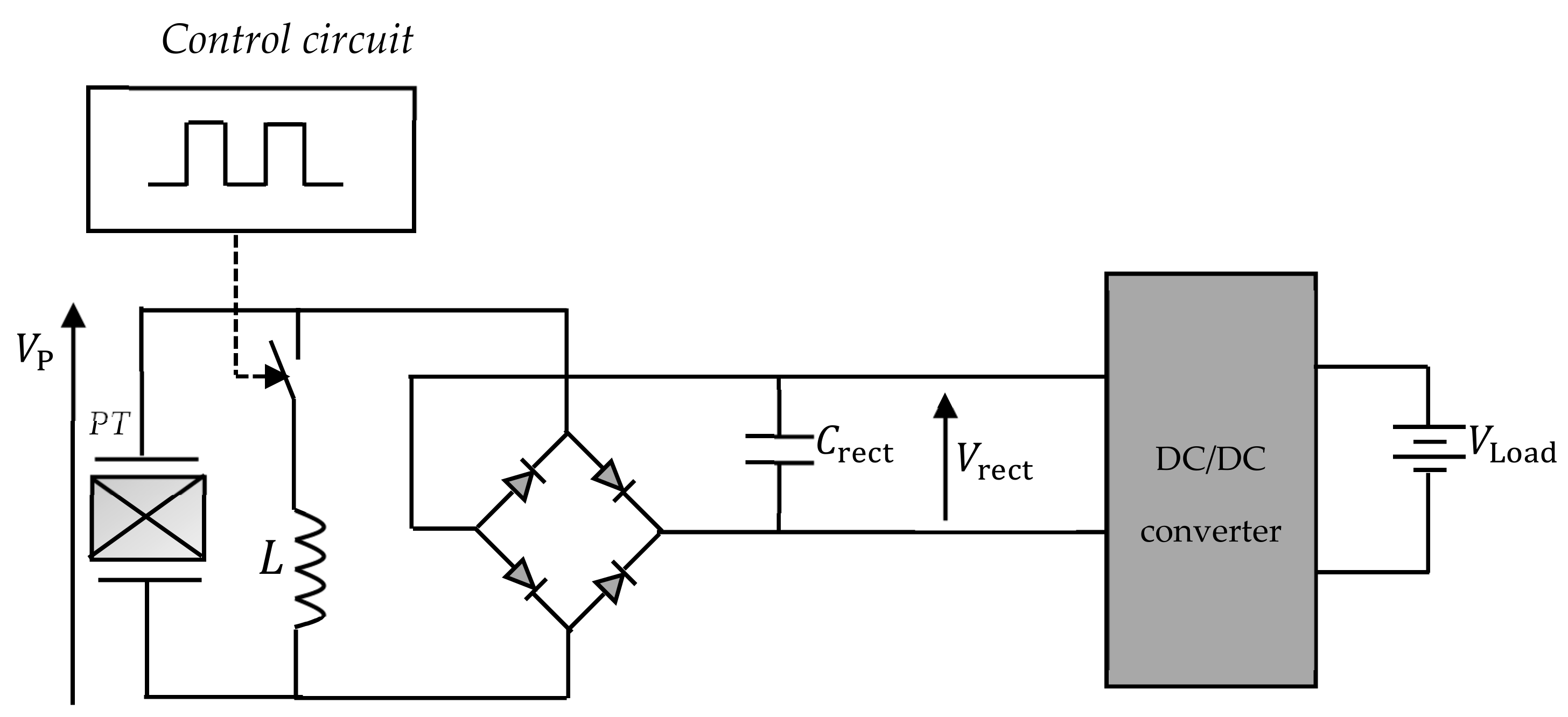
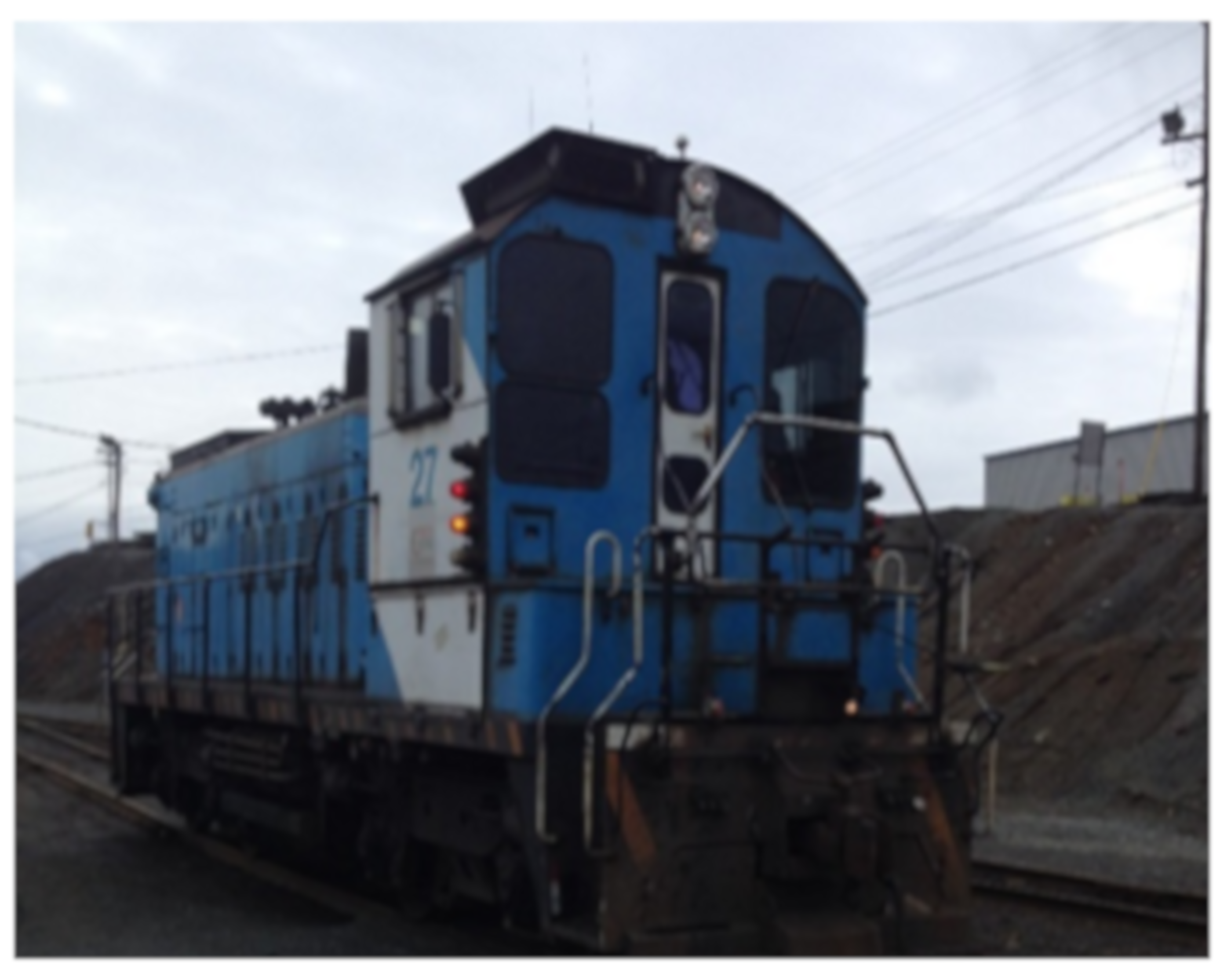


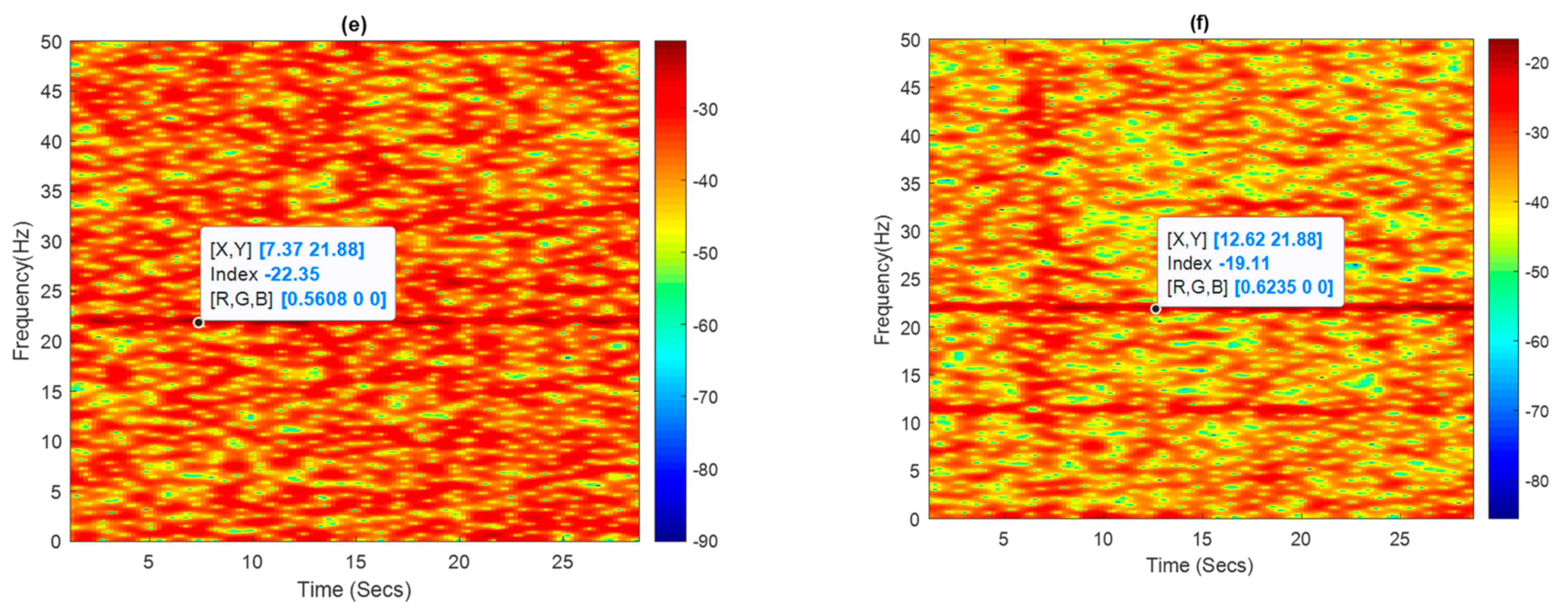

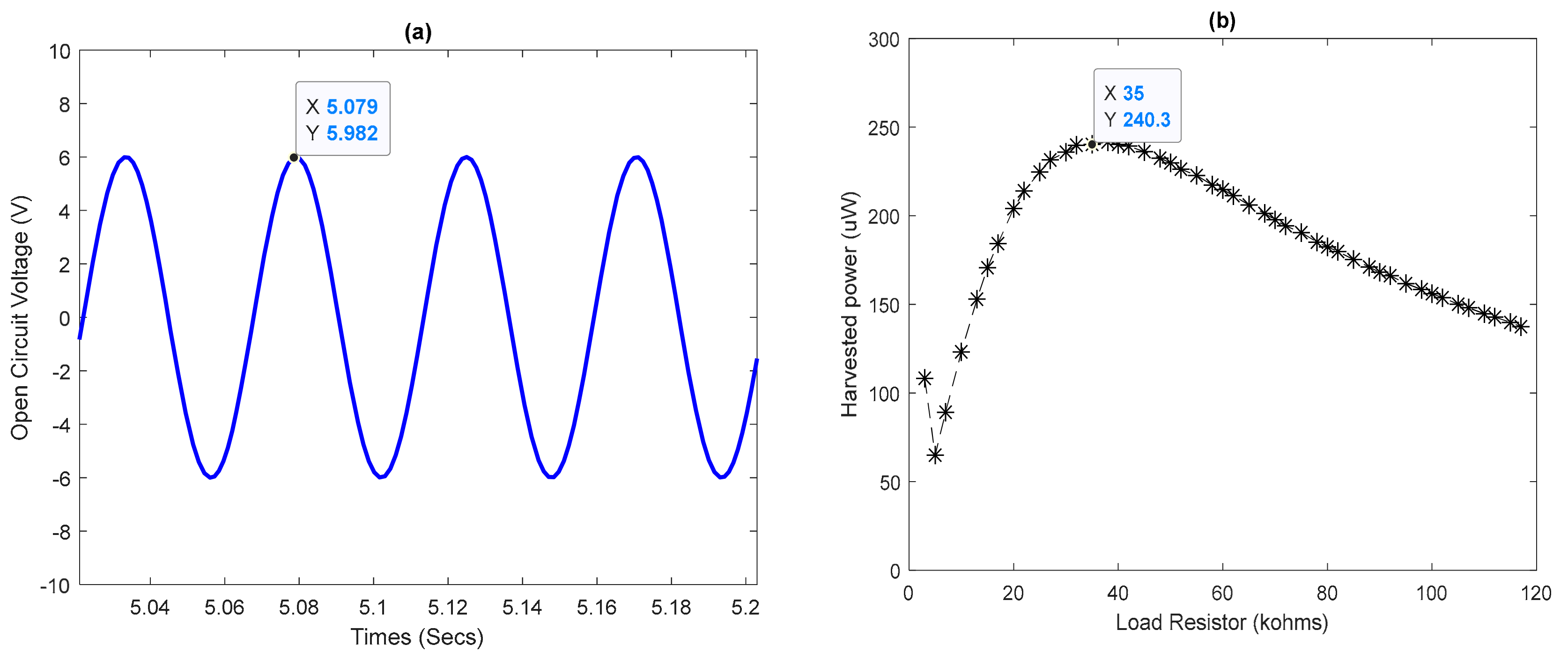
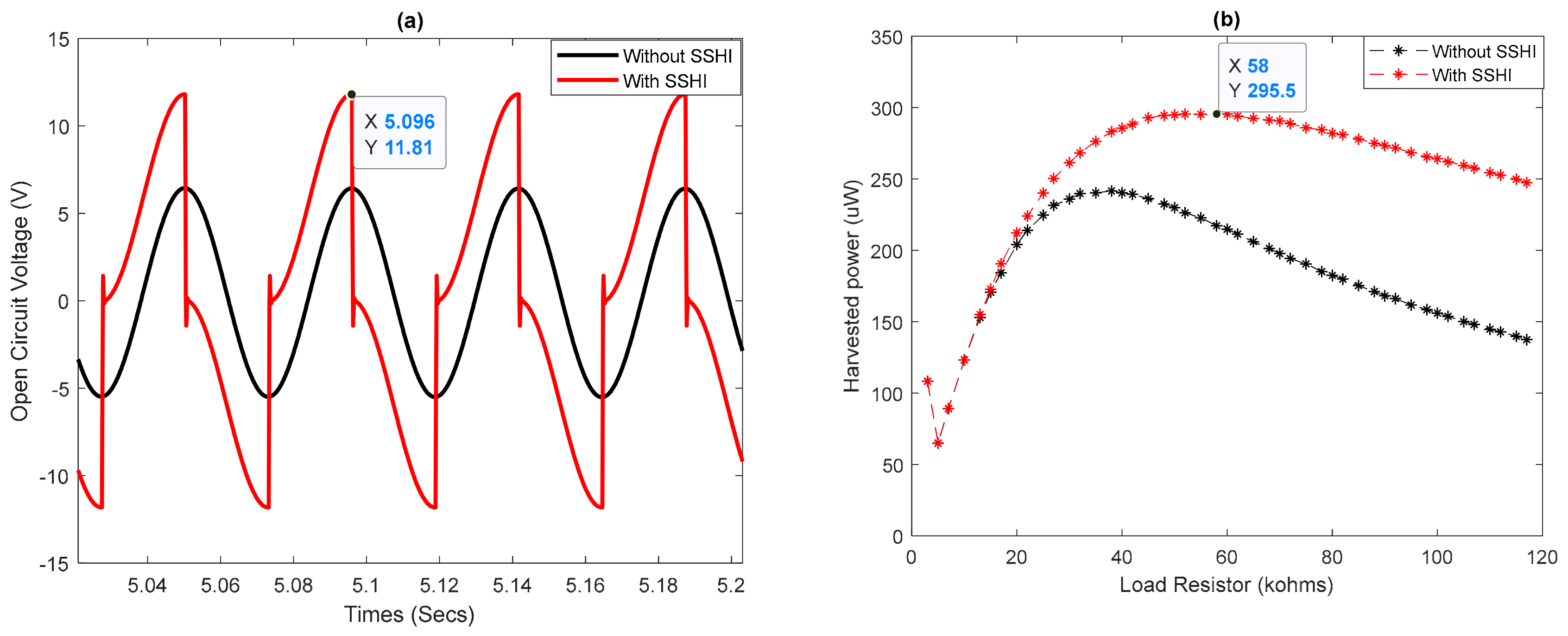
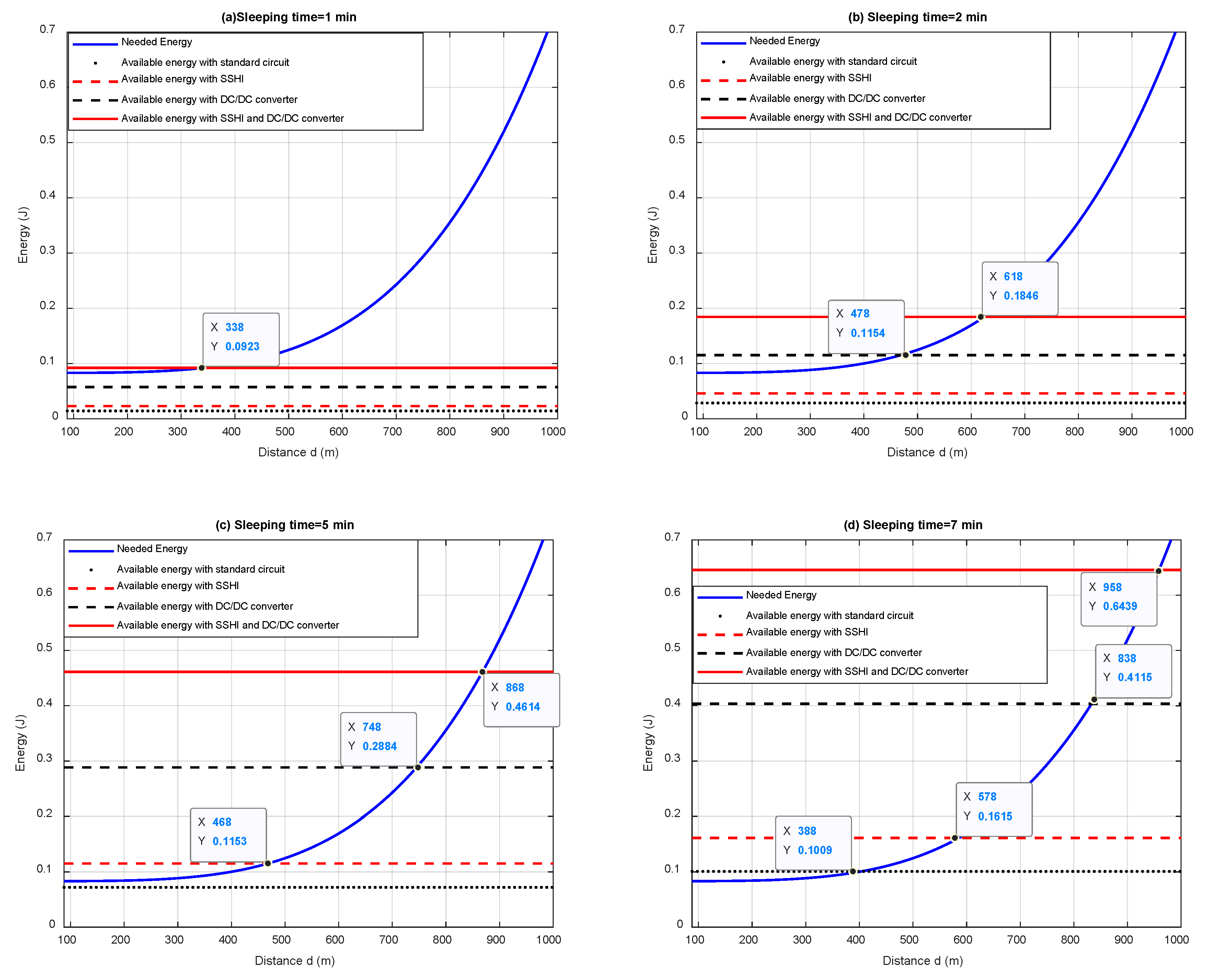
| Ref | PT | EHC | DE * | DC ** | Keys Points |
|---|---|---|---|---|---|
| [8] |
| ||||
| [40] |
| ||||
| [48] |
| ||||
| [49] |
| ||||
| [41] |
| ||||
| [42] |
| ||||
| [43] |
| ||||
| [44] |
| ||||
| [19] |
| ||||
| [45] |
| ||||
| [24] |
| ||||
| [46] |
| ||||
| This paper |
|
| Symbol | Description | Values |
|---|---|---|
| Packet size | ||
| Supply voltage to the sensor | 2.7 V [70] | |
| Distance WS to sink | [34] | |
| Required current for sensing activity | [33] | |
| Current: flash reading 1-byte data | [71] | |
| Current: flash writing 1-byte data | [71] | |
| Time duration for sensor node sensing | [33] | |
| Time duration: flash reading | [71] | |
| Time duration: flash writing | [71] | |
| Number of clock cycles per task | [72] | |
| Leakage current | [72] | |
| Sensor frequency | [65] | |
| Constant depending on the processor | 21.26 [72] | |
| Thermal voltage | 0.2 V [65] | |
| Average Capacitance switched per cycle | [70] | |
| Energy dissipation: electronics | [37] | |
| Transmit amplifier for two ray | [37] |
© 2019 by the authors. Licensee MDPI, Basel, Switzerland. This article is an open access article distributed under the terms and conditions of the Creative Commons Attribution (CC BY) license (http://creativecommons.org/licenses/by/4.0/).
Share and Cite
Mouapi, A.; Hakem, N.; Kandil, N. Cantilevered Piezoelectric Micro Generator Design Issues and Application to the Mining Locomotive. Energies 2020, 13, 63. https://doi.org/10.3390/en13010063
Mouapi A, Hakem N, Kandil N. Cantilevered Piezoelectric Micro Generator Design Issues and Application to the Mining Locomotive. Energies. 2020; 13(1):63. https://doi.org/10.3390/en13010063
Chicago/Turabian StyleMouapi, Alex, Nadir Hakem, and Nahi Kandil. 2020. "Cantilevered Piezoelectric Micro Generator Design Issues and Application to the Mining Locomotive" Energies 13, no. 1: 63. https://doi.org/10.3390/en13010063
APA StyleMouapi, A., Hakem, N., & Kandil, N. (2020). Cantilevered Piezoelectric Micro Generator Design Issues and Application to the Mining Locomotive. Energies, 13(1), 63. https://doi.org/10.3390/en13010063





